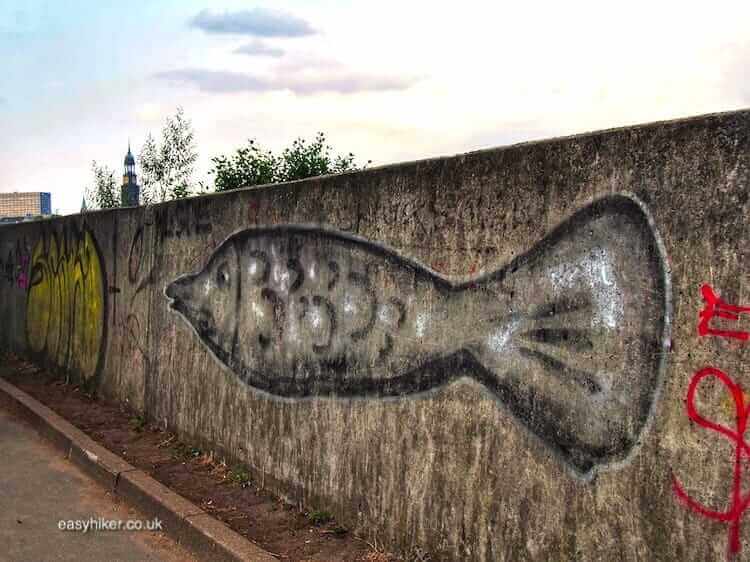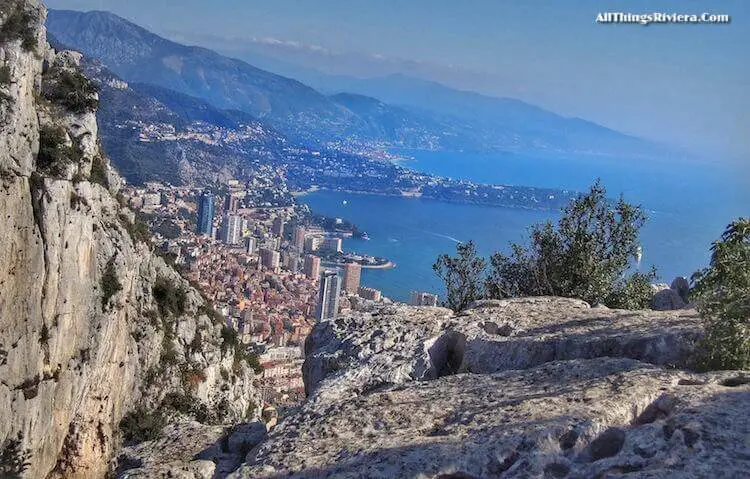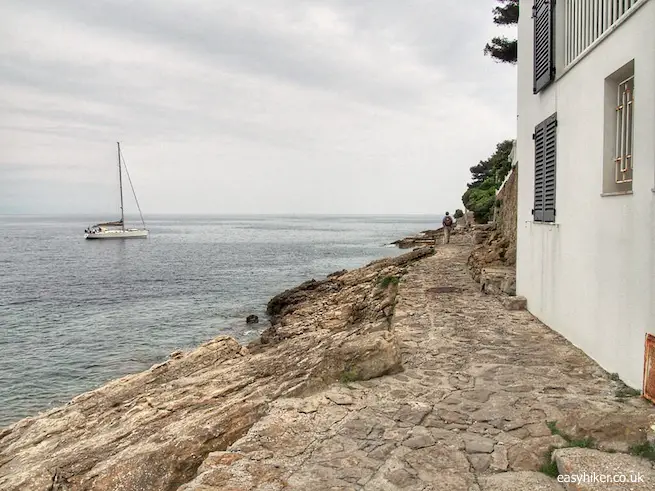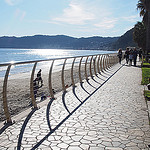What are the must-have ingredients for an entertaining and enjoyable walk? Well, trees and plants, to begin with, …

… then wide open spaces with scenic views into the far distance, …

… and on top of that, some bright sunshine would help, if only to highlight the colours of the scenery with a radiantly blue sky.

Today we are going to demonstrate that you can go for an interesting walk that does not have any of that. You will be surrounded by nature all right, but also be separated from the scenery and its wildlife by impenetrable and opaque walls of steel.
Instead of complaining, you should be grateful for that, because if it were not for these walls, you would not make it out alive.
Let’s go walking with the fishes in Hamburg Harbour
It is said that, wherever you go, you are never further away from a rat than a few metres, but here, you could say the same thing about crustaceans – the artwork on the wall reminds you of the presence of both.

You have probably guessed by now that we are about to take you somewhere wet and underground: into the bowels of the earth.
Correct: today, we will be walking underneath a river, the river Elbe in Hamburg to be precise, exploring the Elbtunnel which has connected the city and the shipyards on Steinwerder river island for over 100 years.

The Elbtunnel of the Hamburg harbour was built between 1907 and 1911. At the time, the ferries of the Elbe could no longer cope with the steadily rising number of people who needed to cross the river from the town centre to the industrial suburb of Steinwerder and back.
In the early 20th century, the shipyards on the island employed more than 20,000 people, and several times a day – at the beginning and at the end of the shifts – long queues and congestion made life miserable for the workers.
On top of that, ferry traffic in winter was frequently obstructed by ice and fog, so both workers and their employers were crying out for a solution.
The most obvious fix would have been to build a bridge, but that was never an option because any such construction would have interfered with the ship traffic in one of the world’s busiest harbours.
Eventually, it was suggested to build a tunnel underneath the river – after all, had British engineers (led by Brunel the elder) not demonstrated the technological feasibility of such an approach when they completed the Thames Tunnel in 1843?
The idea of the Elbtunnel was much discussed and eventually approved in 1901. Six years later, construction works finally began for a 466-metre long tunnel 24 meters under the surface of the Elbe.
Much of the project broke new ground at the time. The shaft buildings, for example, had to be fitted into cramped commercial and industrial environments, so there was no space for ramps: these were replaced by a combination of lifts and stairways.

But more than any of the project’s pioneering innovations, what makes the Elbtunnel so impressive from today’s point of view is its attention to detail – even the (seemingly) less relevant ones.
With all the engineering challenges that had to be addressed, it is amazing that the people in charge of the project still found the time and energy to choose the right light fittings (which have since been carefully restored to their old glory) …

… and to make sure that the architecture reflected a proper balance between style and sobriety, between decoration and seriousness of purpose.

The temptation was clearly to create a structure that would wear its utilitarian character on its sleeve – after all, the tunnel was mainly designed as a route-to-work for the city’s industrial proletariat who would not even be charged for the passage. (Pedestrians’ use of the tunnel has always been free and still is).
If this was the temptation, the architects steadfastly ignored it. It was clearly important to them how everything looked – and how all the individual elements of the structure came together to create a unified whole, from the fittings and fonts of the information panels to the exteriors of the two shaft buildings.
These two buildings on top of the entrances to the tunnel are structurally identical but have been differently clad to match their respective environments, with brick in Steinwerder and granite on the St Pauli harbour jetties.
“Put usefulness first, and you lose it,” the philosopher Roger Scruton says, “put beauty first, and what you create will be useful forever.”

No wonder the Elbtunnel of the Hamburg harbour is such a tourist attraction. Well over one million walkers and cyclists pass the tunnel every year, as many as in the days when it provided the fastest way of crossing the Elbe from downtown Hamburg.
Cross-river car traffic has, since the 1970s, been routed across the 8-lane Neuer Elbtunnel 1 km to the west, a structure with all the typical charm of its period. From what I hear, tourists taking photos there are comparatively thin on the ground.
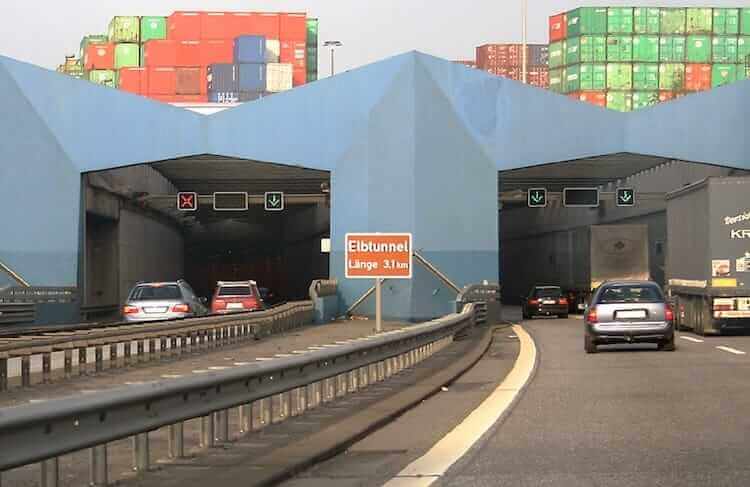
Once you arrive on the Steinwerder side of the Elbtunnel, you should go out to catch some fresh air and have a brief look around.
Do not let your first impression of Steinwerder island scare you into turning back on your heels …

… and take a 180-degree towards your left instead to reach the viewing platform on the river bank.

From there, not only do you get a nice panorama of the city centre but also some scenic harbour views …

… for a rare look at the city from the far side of its river.
This alone would be reason enough for visiting the Elbtunnel.
Walking with the fishes in Hamburg harbour is a unique travel experience in more than one way.
